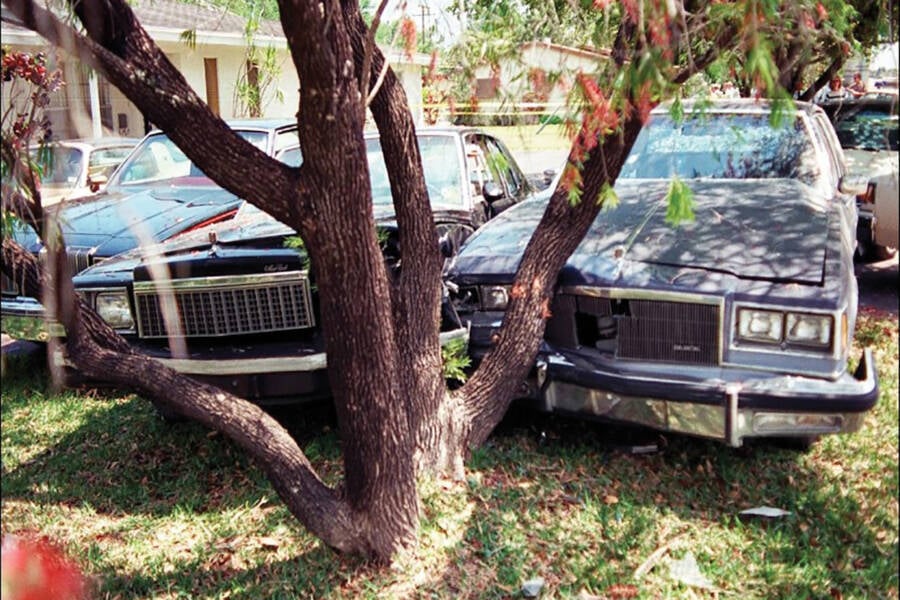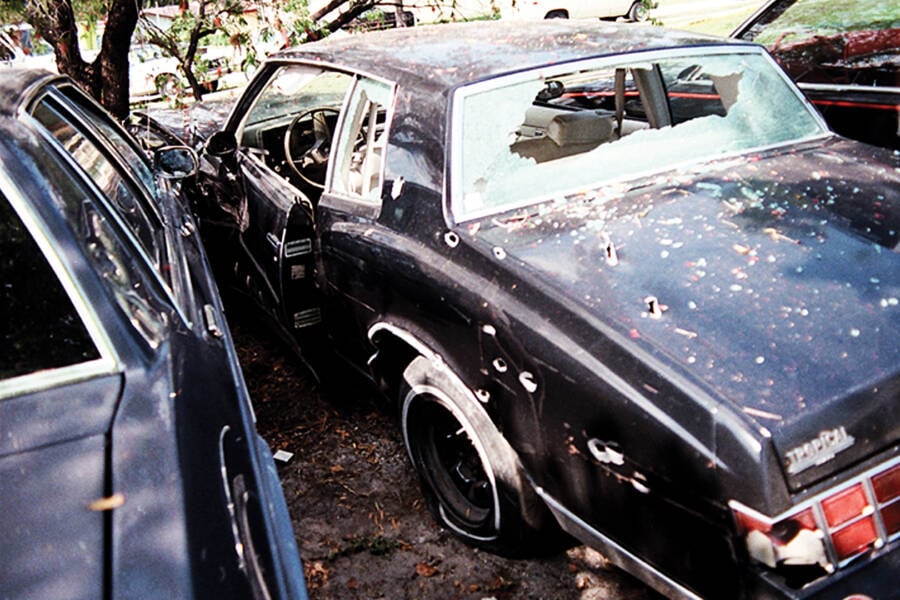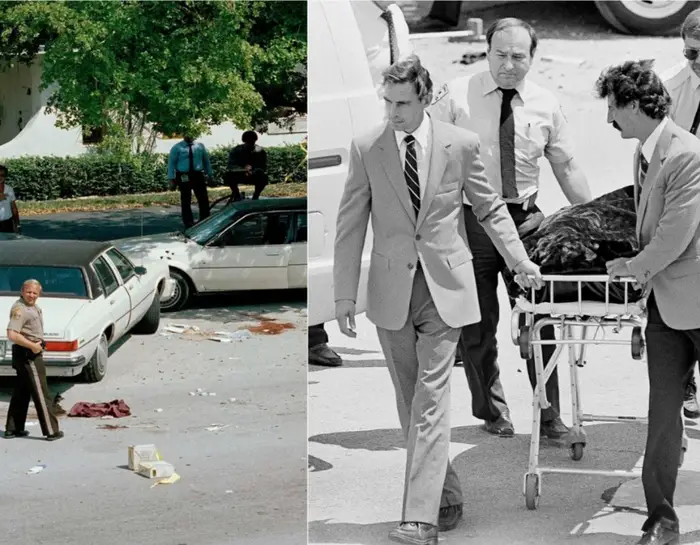On a bright April morning in 1986, a deadly gunfight erupted between a small group of FBI agents and two career criminals in Miami, Michael Platt and William Matix, in what would become one of the deadliest shootouts in FBI history. That single event sent shockwaves across law enforcement, changing the way FBI agents trained, carried weapons, and approached dangerous situations forever.
The Ambush That Triggered Chaos

It was April 11, 1986, when the FBI finally closed in on Platt and Matix, two notorious bank robbers. After months of relentless robberies, their crime spree was coming to an end. The agents had been on their trail for weeks, combing the streets of Miami, hoping to catch them before another innocent life was lost. But this was no Hollywood car chase. It was an ugly, violent ambush.
Just before 10 a.m., three FBI vehicles rammed into the criminals’ stolen Monte Carlo, forcing them off the road. As soon as the dust settled, bullets started flying. The agents, equipped with standard-issue revolvers and only a few shotguns, faced off against Platt and Matix’s automatic weapons. It was like bringing a knife to a gunfight, and it went downhill fast.
In just a few minutes, 145 shots were fired. Two agents lay dead, five were injured, and both Platt and Matix were finally killed. This chaotic shootout, right on the streets of Miami, left a deep scar on the FBI, and it’s still studied in law enforcement training today. But who were these two men who wreaked so much havoc?
Who Were Michael Platt and William Matix?
Long before they became notorious, Michael Lee Platt and William Russell Matix had ordinary lives—at least on the surface. Both men were former military, with Matix serving in the Marine Corps and Platt training as a U.S. Army Airborne Ranger. They met while serving in the Military Police and later became business partners, running a landscaping company called Yankee Clipper.
But something sinister was brewing behind their seemingly normal facades. Their wives both died under suspicious circumstances. Matix’s first wife, Patricia, was found murdered, her throat slit in a hospital lab in Ohio. Matix was a suspect, but the case went cold, and he moved to Florida to start a new life.
Platt’s wife, Regina, died from a shotgun blast to the mouth—a supposed suicide. Weeks after her death, he remarried and resumed his life like nothing had happened. But behind the mask of respectability, the two men were spiraling into a life of crime that would soon turn violent.
The Crime Spree That Led to the Deadly Shootout
In October 1985, Matix and Platt murdered 25-year-old Emelio Briel, an innocent man who was target shooting in a rock pit, just so they could steal his car. They dumped his body in the Florida Everglades, where it wouldn’t be discovered for months. With Briel’s car, they began robbing banks and armored cars across Miami, ruthlessly shooting anyone who got in their way.
Then came their second victim, Jose Collazo. On March 12, 1986, the duo tried to steal Collazo’s car, shooting him four times and leaving him for dead. But unlike Briel, Collazo survived. Despite his injuries, he walked three miles to a police station, giving the FBI the breakthrough they needed: a description of his attackers and their stolen vehicle.
With this information, the FBI started closing in on the two criminals, setting the stage for the tragic showdown.
The Bloodbath on a Miami Street

On April 11, 1986, the chase reached its climax. The FBI had dispatched 14 agents to search for the stolen Monte Carlo along the South Dixie Highway. Special Agents Benjamin Grogan and Jerry Dove were the first to spot the vehicle, and soon the chase was on.
What followed was sheer chaos.
Three FBI vehicles collided with the Monte Carlo, boxing in Matix and Platt. But as the agents scrambled to take control of the situation, the two criminals opened fire with automatic rifles. The agents were outgunned, outflanked, and in a matter of minutes, everything turned deadly. Platt and Matix fired dozens of rounds, seriously injuring several agents.
Special Agents Grogan and Dove, caught in the crossfire, were both killed at point-blank range. Others, like Richard Manauzzi and Gordon McNeill, were gravely injured. It wasn’t until Special Agent Edmundo Mireles, badly wounded himself, managed to fire the fatal shots that brought Platt and Matix down for good.
More Interesting Stories: The Shocking Truth About the Tsavo Lions’ Diet: What DNA Analysis Just Revealed
A Lasting Impact on Law Enforcement
The aftermath of the Miami shootout was devastating. Not only had two agents died in the line of duty, but the sheer firepower the criminals wielded compared to the FBI’s standard revolvers exposed glaring weaknesses in the Bureau’s arsenal.
In the years that followed, the FBI overhauled its weapons training and incident response protocols. Agents were now equipped with semi-automatic pistols and better body armor. These changes weren’t just cosmetic. They reflected a new understanding of the dangers FBI agents faced on the job, and they trickled down into other police departments across the country, contributing to what many call the “militarization” of U.S. law enforcement.
Shocking Revelations After the Shootout
In the wake of the shootout, the FBI reexamined Platt and Matix’s pasts and found disturbing new details. Matix’s second wife, Christy, revealed chilling stories about his abusive behavior, referring to him as a “monster.” And Platt’s wife’s supposed suicide came under renewed scrutiny. Some detectives now believed it might have been murder.
The violence of the Miami shootout had ended, but the dark secrets of Platt and Matix continued to cast a long shadow over their legacy. These two men, who had once seemed like model citizens, were now remembered as cold-blooded killers who had taken countless lives and left a trail of destruction in their wake.
The Legacy of the 1986 FBI Miami Shootout
The FBI Miami shootout remains a critical turning point in U.S. law enforcement history. It not only led to sweeping changes in FBI training and weaponry but also sparked broader debates about the increasing militarization of police forces across the country.
For those who study the incident today, the lesson is clear: preparation, equipment, and training can make the difference between life and death in the line of duty. But for the families of the fallen agents—like Benjamin Grogan and Jerry Dove—the event is a somber reminder of the ultimate sacrifice law enforcement officers make to keep others safe.
What To Do?
Want to learn more about how this shootout changed American law enforcement? Share this article with your friends and leave your thoughts in the comments. Let’s discuss how far we’ve come—and how much further we have to go—in making sure our law enforcement officers have the tools and training they need to protect and serve.

